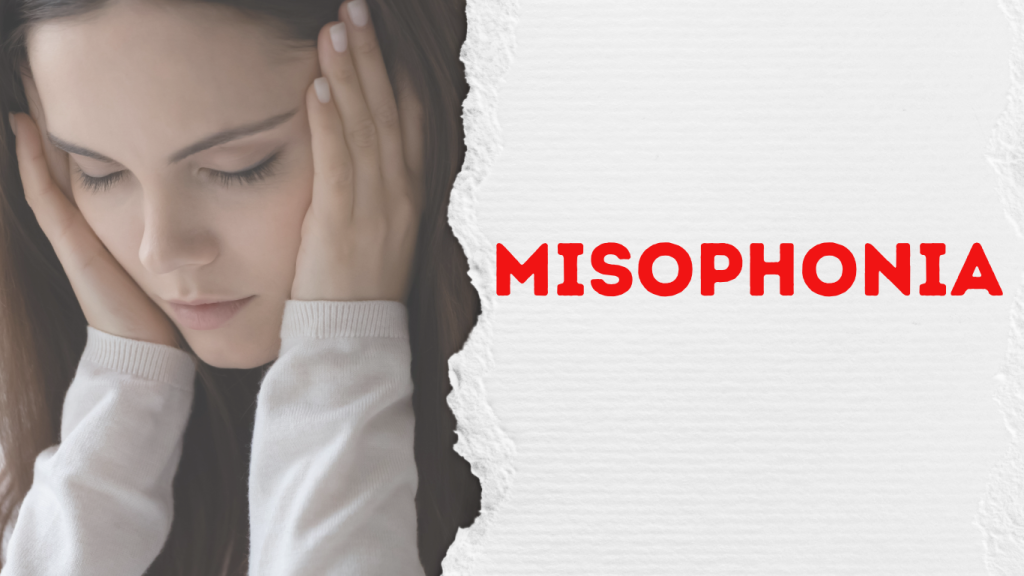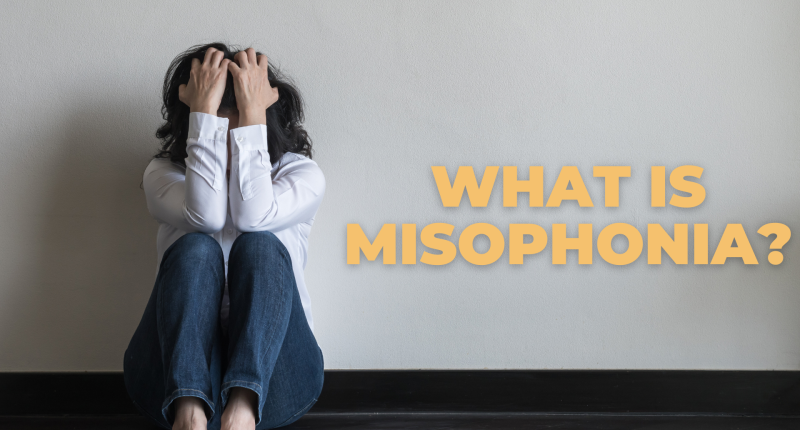Misophonia, a condition characterized by an intense emotional reaction to specific sounds, has been a topic of growing interest in recent years. While it is not officially recognized as a mental disorder, researchers and healthcare professionals are working to understand this condition better and develop effective treatment strategies. In this article, we will explore the symptoms of misophonia, its potential classification as a mental illness, and the current state of treatment options.

What is Misophonia?
Misophonia is not merely a dislike of certain sounds; it is a complex disorder that can provoke severe emotional and physiological responses. Common triggers include sounds associated with human activities, such as chewing, breathing, pen clicking, and tapping. According to research, these sounds can evoke a range of reactions, including irritation, agitation, and even rage. A study published in the Journal of Clinical Psychology highlights that about 80% of individuals with misophonia report negative reactions to mouth-related sounds, indicating a prevalent sensitivity to bodily noises.
The condition typically manifests in childhood or adolescence, with many individuals recalling specific instances where they first experienced these intense reactions. The emotional responses can be disproportionate to the stimuli, leading to significant distress and avoidance behaviors. For example, someone with misophonia may avoid social situations where they anticipate encountering triggering sounds, leading to social isolation and decreased quality of life.
Key Characteristics of Misophonia
- Trigger Sounds: Common triggers include sounds like chewing, slurping, breathing, pen clicking, and tapping. These sounds often evoke a strong emotional response that can be disproportionate to the sound itself.
- Emotional Responses: The reactions can vary from mild irritation to intense anger or panic. Some individuals may even experience physiological symptoms such as increased heart rate or sweating.
- Avoidance Behavior: Many people with misophonia develop strategies to avoid trigger sounds, which can lead to social isolation or difficulties in work and personal relationships.
Who Does Misophonia Affect?
Misophonia can affect individuals of all ages, genders, and backgrounds, although some demographic factors may influence prevalence rates:
- Age: Misophonia typically begins in childhood or adolescence, with an average age of onset around 13 years old. Prevalence rates appear to be higher in younger age groups and decrease with advancing age.
- Gender: Studies suggest that misophonia is more common in females, with approximately 60-70% of those affected being women. However, the reasons for this gender disparity are not yet fully understood.
- Family History: Misophonia may have a genetic component, as studies have found that 22-43% of those with misophonia report having first-degree relatives with similar symptoms.
- Mental Health Conditions: Individuals with misophonia often have comorbid psychiatric disorders, such as obsessive-compulsive disorder (OCD), anxiety disorders, attention-deficit/hyperactivity disorder (ADHD), and autism spectrum conditions. However, the exact relationship between misophonia and these conditions is still being investigated.
- General Population: Recent epidemiological studies suggest that misophonia is relatively common in the general population, with prevalence rates ranging from 5-19%. However, more research is needed to establish a precise estimate of the condition’s overall impact.
Misophonia can affect anyone, certain demographic factors and mental health conditions may increase an individual’s risk of developing the condition. As awareness of misophonia grows, more research is needed to fully understand its prevalence, risk factors, and impact on quality of life across diverse populations.
Symptoms and Reactions
The symptoms of misophonia can vary widely among individuals but generally include:
- Emotional Responses: Feelings of anger, irritation, and anxiety when exposed to trigger sounds.
- Physical Reactions: Increased heart rate, muscle tension, and even panic attacks can occur in response to auditory stimuli.
- Behavioral Changes: Some individuals may exhibit aggressive behaviors towards the source of the sound or resort to avoidance strategies to escape triggering environments.
- Cognitive Distress: Many experience anticipatory anxiety, fearing exposure to known triggers, which can lead to a perpetual state of hyper-vigilance.
Is Misophonia a Mental Illness?
The classification of misophonia as a mental illness is not straightforward. Currently, it is not included in major diagnostic manuals such as the DSM-5 (Diagnostic and Statistical Manual of Mental Disorders) or the ICD-11 (International Classification of Diseases). This absence raises questions about its status within the psychiatric community.
Arguments for Classification as a Mental Disorder
- Emotional and Physiological Responses: Misophonia is marked by intense emotional reactions, including anger and anxiety when exposed to certain sounds. These responses can lead to significant distress and impairment in social, occupational, or academic functioning, which are common criteria for mental disorders.
- Comorbidity with Other Disorders: Research indicates a high rate of comorbidity between misophonia and other psychiatric disorders, such as obsessive-compulsive disorder (OCD), anxiety disorders, and depression. A study found that 26% of individuals with misophonia exhibited traits of obsessive-compulsive personality disorder, and 10% had mood disorders. This overlap suggests that misophonia may share underlying mechanisms with recognized mental health conditions.
- Emerging Consensus: Recent discussions among researchers have led to the proposal that misophonia should be classified as a psychiatric disorder. A structured study in 2022 resulted in a consensus definition of misophonia, emphasizing its nature as a disorder characterized by decreased tolerance to specific sounds. This growing body of evidence supports the argument for its inclusion in future editions of diagnostic manuals.
Counterarguments Against Classification
- Lack of Consensus: Despite the emerging consensus, there is still considerable debate regarding the classification of misophonia. Some researchers argue that it may simply be a feature of a broader pattern of sensory intolerance rather than a standalone disorder.
- Stigmatization Concerns: There are concerns that classifying misophonia as a mental disorder could lead to stigmatization and over-pathologization of normal human experiences. Critics argue that many people experience annoyance to certain sounds without it being classified as a disorder.
- Need for Further Research: The current understanding of misophonia is limited, and more research is needed to establish clear diagnostic criteria and validate its classification. The lack of consensus on diagnostic tools and criteria hampers the ability to rigorously assess the disorder and its treatment.
As awareness of misophonia increases, so does the importance of understanding its implications for those affected. Continued research efforts may ultimately clarify whether misophonia should be classified as a mental disorder, paving the way for more effective treatment and support for individuals experiencing this condition.
Treatment Options for Misophonia
Treatment for misophonia is still evolving, with limited empirical support for specific interventions. However, several approaches have shown promise:
- Cognitive Behavioral Therapy (CBT): CBT has emerged as a leading treatment modality, helping individuals reframe their responses to trigger sounds and develop coping strategies.
- Exposure Therapy: Gradual exposure to triggering sounds in a controlled environment can help desensitize individuals over time.
- Medication: While no specific medications exist for misophonia, treatments for anxiety and OCD may alleviate associated symptoms.
- Self-Management Strategies: Techniques such as mindfulness, relaxation exercises, and the use of noise-canceling headphones can help individuals manage their reactions.
Current Research and Future Directions
Recent studies have focused on various aspects of misophonia, including its etiology, symptomatology, and potential treatment options. A systematic review published in 2022 analyzed a wide range of studies on misophonia, highlighting the need for further exploration of its diagnostic criteria, comorbidities, and assessment tools. The review also emphasized the importance of understanding misophonia from multiple disciplinary perspectives, including neuroscience, psychology, and audiology.
Key Findings
- Prevalence and Impact: Research indicates that misophonia is more common than previously thought, with estimates suggesting that nearly 20% of adults in the UK may experience this condition. Misophonia can significantly disrupt daily life, leading to social withdrawal and emotional distress.
- Comorbidity: Studies have shown a high rate of comorbidity between misophonia and other psychiatric disorders, such as anxiety and obsessive-compulsive disorder (OCD). This overlap suggests that misophonia may share underlying mechanisms with these conditions, warranting further investigation into their interrelationships.
- Neuroscientific Insights: New research is exploring the neurological basis of misophonia. For instance, studies have begun to examine brain activity in response to trigger sounds, revealing potential differences in how individuals with misophonia process auditory stimuli compared to those without the condition.
Advances in Treatment Approaches
As research progresses, various treatment modalities are being investigated for their efficacy in managing misophonia symptoms:
- Cognitive Behavioral Therapy (CBT): CBT has emerged as a promising treatment option, helping individuals reframe their responses to trigger sounds. Recent studies suggest that group CBT may significantly reduce misophonia symptoms.
- Exposure Therapy: Gradual exposure to triggering sounds in a controlled setting may help desensitize individuals over time. This approach has shown promise in case studies, indicating its potential as a viable treatment option.
- Pharmacological Interventions: While no specific medications exist for misophonia, researchers are exploring the use of existing treatments for anxiety and OCD to alleviate associated symptoms. Ongoing studies are assessing the effectiveness of various pharmacological interventions.
Future Directions for Research
Despite the progress made in understanding misophonia, several areas require further exploration:
- Standardized Diagnostic Criteria: The lack of consensus on diagnostic criteria for misophonia hampers research efforts. Establishing standardized definitions and assessment tools will enable more rigorous comparisons between studies and facilitate the development of effective treatments.
- Longitudinal Studies: Long-term studies examining the progression of misophonia over time will provide valuable insights into its etiology and potential changes in symptom severity. Understanding how misophonia evolves can inform treatment approaches and improve patient outcomes.
- Multidisciplinary Approaches: Future research should adopt a multidisciplinary perspective, incorporating insights from audiology, psychiatry, psychology, and neuroscience. Collaborative efforts among researchers from diverse fields will enhance the understanding of misophonia and lead to more comprehensive treatment strategies.
- Exploration of Genetic Factors: Investigating potential genetic predispositions to misophonia may yield important insights into its underlying mechanisms. Understanding the biological basis of the condition could lead to more targeted interventions and personalized treatment options.
Celebrities with Misophonia
Melissa Gilbert
Melissa Gilbert, best known for her role in “Little House on the Prairie,” has openly discussed her struggles with misophonia. In a recent interview, she revealed that everyday sounds, like chewing and nail tapping, would trigger intense emotional responses during her childhood. Gilbert described feelings of guilt and isolation, believing her reactions made her a “bad person.” It wasn’t until later in life that she learned about misophonia and began to seek help, including cognitive behavioral therapy, which has provided her with tools to manage her condition effectively.
Kelly Ripa
Television host Kelly Ripa has also shared her experiences with misophonia, particularly her aversion to chewing sounds. During interviews, she has recounted moments where the noise of her children eating would provoke a strong urge to react, often leading to frustration. Ripa’s candid discussions about her condition have helped raise awareness and foster understanding among her audience, emphasizing that her reactions are not personal but rather a neurological response beyond her control.
Kelly Osbourne
Kelly Osbourne has been diagnosed with misophonia, a condition she initially struggled to understand. She has described her intense reactions to sounds like chewing and slurping, often feeling anxious and overwhelmed in social situations. Osbourne’s openness about her diagnosis has contributed to greater visibility of misophonia, helping others recognize that it is a legitimate condition rather than a mere quirk.
Melanie Lynskey
Actress Melanie Lynskey’s sensitivity to sound has also been highlighted by her husband, who noted that she perceives certain noises at a significantly amplified level. This heightened sensitivity can lead to feelings of rage and frustration, particularly in environments where loud eating or drinking occurs. Lynskey’s experiences illustrate the challenges faced by those with misophonia, as well as the importance of supportive relationships in managing the condition.
Other Notable Figures
In addition to these celebrities, others like Sarah Silverman and Richard E. Grant have shared their misophonia experiences. These personal accounts contribute to a broader understanding of the condition and highlight the need for empathy towards those affected.
FAQs
Q. Is misophonia a recognized mental illness?
A. Misophonia is not officially recognized as a mental illness in diagnostic manuals, but it is increasingly acknowledged by professionals as a legitimate condition that can significantly impact the quality of life.
Q. What are common triggers for misophonia?
A. Common triggers include sounds related to eating, breathing and repetitive noises like pen clicking or tapping.
Q. Can misophonia be treated?
A. Yes, various treatment options, including cognitive behavioral therapy and sound therapy, have shown promise in managing symptoms.
Q. Is there a cure for misophonia?
A. Currently, there is no known cure for misophonia, but many individuals find effective ways to manage their symptoms through therapy and coping strategies.
Q. How can someone cope with misophonia in daily life?
A. Coping strategies include using noise-canceling headphones, practicing mindfulness, and communicating with friends and family about the condition to foster understanding and support.
Conclusion
Misophonia presents a unique challenge that intertwines emotional responses with everyday experiences. As awareness grows, so does the need for effective treatment and recognition of this condition within the mental health community. Understanding its symptoms and exploring treatment options can empower individuals to reclaim their lives from the grip of sound sensitivity. While more research is needed to develop standardized protocols, the current state of treatment offers hope for those struggling with misophonia.
Also Read | MICE Therapy Improves Mental Health in Children with Epilepsy










